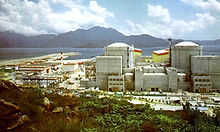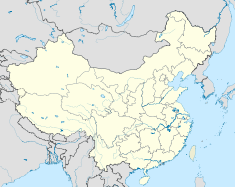- Daya Bay Nuclear Power Plant
-
Daya Bay Nuclear Power Plant 
Daya Bay nuclear power plantLocation of Daya Bay Nuclear Power Plant Country People's Republic of China Location Longgang District, Shenzhen, Guangdong Coordinates 22°36′N 114°33′E / 22.6°N 114.55°ECoordinates: 22°36′N 114°33′E / 22.6°N 114.55°E Status Operational Commission date Unit 1: August 31, 1993
Unit 2: February 2, 1994Operator(s) Guangdong Nuclear Power Joint Venture Company (GNPJVC)[1] Reactor information Reactors operational 2 x 944 MWe (net)
2 x 984 MWe (gross)Reactor type(s) PWR - CPR-1000 Reactor supplier(s) China Guangdong Nuclear Power Group Daya Bay Nuclear Power Plant is located on Daya Bay in Longgang District, Shenzhen, Guangdong, People's Republic of China, north of Hong Kong. Daya Bay has two 944 MWe PWR nuclear reactors based on the Framatone ANP French 900 MWe three cooling loop design,[2] which started commercial operation in 1993 and 1994.[3]
Contents
History
Although located within Guangdong Province, in 1985 the building of Daya Bay nuclear power plant incited controversies and raised objections from prominent politicians in the neighboring Hong Kong, such as Martin Lee and Szeto Wah, legislative councilors, district board members. A million people, or one fifth of Hong Kong's population, signed a petition opposing nuclear power. Over a hundred community groups dealt with the construction topics with the opposition focusing on environmental issues and the rights of Hong Kong residents.[4]
Unit 1 began power operations on August 31, 1993, and Unit 2 began power operations on February 2, 1994. The reactors were designed and built by the French National Company, Framatome, with Chinese participation. Daya Bay is 25% owned by Hong Kong-listed CLP Holdings, which buys about 70% of the plant's output to supply Hong Kong's power needs.[5]
On June 16, 2010 Radio Free Asia[6] informed that there was a leak in one of the fuel tubes. Officials denied this information stating that "Daya Bay's two reactor units are functioning safely and stably. There has been no radioactive leak". Radio Free Asia quotes a unidentified expert, that radioactive Iodine has been released. It also informs, that the incident was not initially reported to the government, but was kept secret for some time. The New York Times reported differently, quoting one of the shareholders of the plant, China Light & Power (CLP), a Hong Kong-based utility, that the government nuclear safety watchdog in both mainland China and Hong Kong were notified and briefed. CLP said in a statement that the leak was small and fell below international standards requiring reporting as a safety issue. No radioactive monitoring stations in Hong Kong detected any rise in radioactivity.[7] Mainland news outlets also quoted officials explaining the situation, which was under normal operation conditions and fell below international standards for reporting.
The plants are named Guangdong-1 and Guangdong-2 in the IAEA PRIS database.[3]
Safety Awards
In April 2011, Dayawan Power Plant won an unprecedented four out of six awards in the annual nuclear power plant safety competition held by EDF Energy.
Not only was it the first time a Chinese power company had achieved this, but also the first time any nuclear power company achieved this feat.
"Everyone was shocked by Dayawan's figures, especially for repairs and maintenance," said Liu Changshen, General Manager of Dayawan Nuclear Power Company. "We stood at 19.7 days last year. France has many reactors - their record is more than 23.
Second is our non-stop operation - all our reactors are in use simultaneously for 6 months, so overall its 3,000 days."
The Dayawan Nuclear Power Plant also stands out from the other 63 reactors as its staff are exposed to a minimal amount of radiation - only 0.8 millisieverts. That's equivalent to the exposure of one out of 400 people when having an X-ray.[8]See also
- Daya Bay Reactor Neutrino Experiment
- Ling Ao Nuclear Power Plant
- Nuclear power in China
- CPR-1000
- 2011 Huizhou refinery explosion incident
References
- ^ "Nuclear Power Reactor Details - GUANGDONG 1". Power Reactor Information System (PRIS). International Atomic Energy Agency. http://www.iaea.org/cgi-bin/db.page.pl/pris.prdeta.htm?country=CN&site=GUANGDONG&units=&refno=2&link=HOT&sort=&sortlong=. Retrieved 2010-07-18.
- ^ "Fuel loading starts at new Chinese reactor". World Nuclear News. 22 April 2010. http://www.world-nuclear-news.org/NN-Fuel_loading_starts_at_new_Chinese_reactor-2204104.html. Retrieved 18 July 2010.
- ^ a b "China, People's Republic of: Nuclear Power Reactors". PRIS database. International Atomic Energy Agency. http://www.iaea.org/cgi-bin/db.page.pl/pris.powrea.htm?country=CN. Retrieved 18 July 2010.
- ^ Asiasociety.org
- ^ [1]
- ^ China nuclear firm denies leak, admits tube cracks
- ^ Bradsher, Keith (June 15, 2010). "Chinese Nuclear Plant Experienced a Small Leak Last Month, a Stakeholder Says". The New York Times. http://www.nytimes.com/2010/06/16/world/asia/16china.html. Retrieved 2010-07-18.
- ^ http://www.bjreview.com.cn/special/2011-04/08/content_349965.htm
External links
- Hong Kong Nuclear Investment Co. Ltd (Flash Player required)
- Daya Bay Reactor Neutrino Experiment Website
Nuclear power in China Operating power plants Power plants under construction Planned power plants Proposed power plants Anhui: Jiyang • Chongqing: Fuling · Shizu • Gansu: Lanzhou • Guangdong: Haijia · Hebaodao · Heyuan • Guangxi: Pingnan • Hebei: Qiaofushan • Henan: Nanyang · Xinyang • Hubei: Guangshui • Hunan: Changde · Xiangtan • Jiangxi: Yingtan • Jilin: Jingyu • Liaoning: Donggang · Hengren · Jinzhouwan • Shandong: Shidaowan • Sichuan: Nanchong · Yibin • Zheijiang: Cangnan
Other reactors Organizations China Atomic Energy Authority · China Guangdong Nuclear Power Group · China National Nuclear Corporation · China Nuclear Engineering & Construction Corporation · China Nuclear International Uranium Corporation · Chinese Nuclear Society · Nuclear Power Institute of China · State Nuclear Power Engineering Corporation · State Nuclear Power Technology Corporation
Categories:- Nuclear power stations in China
- Buildings and structures in Guangdong
- 1993 establishments in China
- Nuclear power stations using pressurized water reactors
Wikimedia Foundation. 2010.

